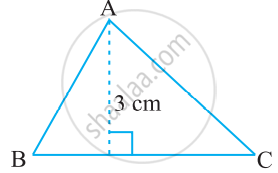Advertisements
Advertisements
Question
Find the area of a triangle whose vertices are
(a, c + a), (a, c) and (−a, c − a)
Solution
We know area of triangle formed by three points (x1y1) , (x2y2), and (x3y3)is given by `triangle=1/2 [x_1(y_2-y_3)+x_2(y_3-y_1)+x_3(y_1-y_2)]`
The vertices are given as (a, c + a), (a, c) and (−a, c − a)
Δ = 1/2[a (c-c+a) + a(c-a-c-a)-a(c+a-c)
= 1/2[a(a)+a(2a)-a(a)]
= 1/2 [-2a2]=a2
APPEARS IN
RELATED QUESTIONS
If D, E and F are the mid-points of sides BC, CA and AB respectively of a ∆ABC, then using coordinate geometry prove that Area of ∆DEF = `\frac { 1 }{ 4 } "(Area of ∆ABC)"`
Find the centre of a circle passing through the points (6, − 6), (3, − 7) and (3, 3).
The two opposite vertices of a square are (− 1, 2) and (3, 2). Find the coordinates of the other two vertices.
If `a≠ b ≠ c`, prove that the points (a, a2), (b, b2), (c, c2) can never be collinear.
Find the value of y for which the points A(-3, 9), B(2,y) and C(4,-5) are collinear.
Find a relation between x and y, if the points A(x, y), B(-5, 7) and C(-4, 5) are collinear.
What is the area of a triangle with base 4.8 cm and height 3.6 cm?
Find BC, if the area of the triangle ABC is 36 cm2 and the height AD is 3 cm.

If the points A(1, 2), O(0, 0) and C(a, b) are collinear, then ______.
Find the value of m if the points (5, 1), (–2, –3) and (8, 2m) are collinear.
